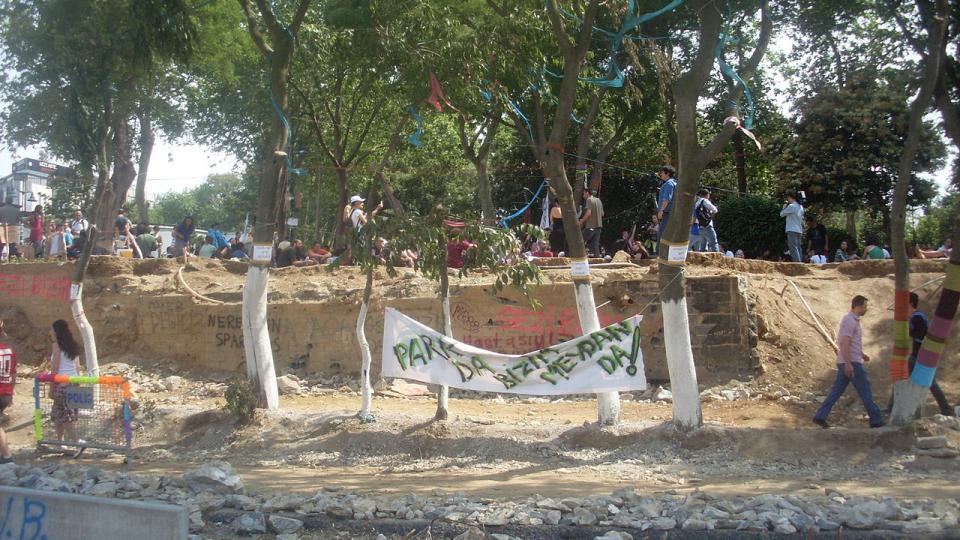On the night of 27 May 2013, activists mobilized via social media to save the trees at Gezi Park, near Taksim Square, one of the last public green spaces left in the main center of Istanbul on the European side. This green patch was to be destroyed in order to make way for a shopping mall. Fewer than a dozen activists managed to halt the bulldozers and prevented the park from demolition. Following severe police intervention, citizens poured into the streets to support environmental activists, and events turned into the largest resistance movement Turkey had seen for decades. The Gezi Park uprising had bitter consequences: eleven people were killed and more than 8,000 were injured. But eventually, the protesters saved the trees.

The location of the bulldozed trees on May 27, 2013, at Gezi Park.
The location of the bulldozed trees on May 27, 2013, at Gezi Park.
Photograph by VikiPicture.
Accessed via Wikimedia on 15 May 2019. Click here to view source.
 This work is licensed under a Creative Commons Attribution-ShareAlike 3.0 Unported License.
This work is licensed under a Creative Commons Attribution-ShareAlike 3.0 Unported License.
In subsequent years, similar protests unfolded in Budapest, Hungary, where a bitter dispute erupted over the city’s oldest public park: Városliget (literary “City Park”). Here, the first demonstration took place on 13 June 2014. Sporadic activism grew into a Gezi Park-style Occupy movement by March 2016, when a group of activists raided demolition sites in the Városliget and aimed to stop the government-backed construction megaproject. Since 2016, conflicts between protesters and private security as well as riot police forces became regular. The core group of activists, “Protectors of the Park” (Ligetvédők) are still active at the time of the submission of this article. The dramatic events at Gezi Park and Városliget seemingly do not have historical roots; they spring up locally, employ civic energy, and react to contemporary problems. However, Gezi Park and Városliget events may suggest as well a different interpretation as well, rooted in history, where environmental history may be employed as a valuable analytical tool for framing contemporary environmental protests.
Social science research has often focused on grassroots environmentalism under authoritarian regimes by analyzing citizens’ initiatives and interpreting them as forms of resistance against authoritarian power. Despite its unquestionable merits, this school of thought often left out the analysis of environmental protection and conservation efforts of authoritarian regimes and state actors. One of the reasons for providing little, if any, space for the understanding of the relationship between the environment and authoritarian regimes was the presumption that authoritarian leaders did not pay attention to such matters anyway.

Protests against the Liget project in March 2016.
Protests against the Liget project in March 2016.
Photograph by Elekes Andor, 28 March 2016.
Accessed via Wikimedia on 15 March 2019. Click here.
 This work is licensed under a Creative Commons Attribution-ShareAlike 4.0 International License.
This work is licensed under a Creative Commons Attribution-ShareAlike 4.0 International License.
Environmental protection under authoritarian regimes is not among the top research problematiques of environmental historians. However, despite the question’s relative marginality, a good number of scholarly accounts have been published on the environmental history of authoritarian regimes, with particular concentration on environmentalist and conservation efforts (e.g., Brain and Pál 2018; Bruno 2016; Gille 2007; Pál 2017, Uekötter 2006; Weiner 1988, 1999). For example, Stephen Brain’s study “The Song of the Forest” (2011) interprets environmentalism broadly and underlines that environmentalism did exist in Stalin’s Soviet Union, even within the state apparatus.
We have conducted our historical investigations in this vein and completed our doctoral projects on the environmental history of Turkey and Hungary. During our investigations, we have come to learn that historical sources under authoritarian regimes may differ from those frequently used in Western industrialized countries. These differences reflect the way political, economic, and environmental institutions are built up. Moreover, such differences have direct implications when it comes to environmentalist and conservationist discourses. This is why it is important to understand that, because of the different structures and actors of the state under authoritarian conditions, stakeholders, environmentalist claims, and environmental issues often present alternative examples to the ones we are used to seeing in democratic countries.

City Park in 1941 in the vicinity of Stefánia road.
City Park in 1941 in the vicinity of Stefánia road.
Courtesy of FORTEPAN / Szekrényesy Réka.
Accessed via FORTEPAN on 4 June 2019. Click here to view source.
 This work is licensed under a Creative Commons Attribution-ShareAlike 3.0 Unported License.
This work is licensed under a Creative Commons Attribution-ShareAlike 3.0 Unported License.
Such historical examples have direct implications for contemporary societies. Today, interpretations of environmentalism under authoritarian regimes often concentrate on the repression of civic society, grassroots environmentalism versus the technocratism dictated by the ruling elite, and exist within the framework of state modernism. Our environmental history research on the environmental history of Turkey and Hungary suggests, however, that environmentalism and conservation may be part of a more multifaceted societal discourse, including various perceptions and agendas concerning the environment in authoritarian regimes (Brain and Pál 2018; İnal and Turhan 2019; Pál 2017). Additionally, environmental histories of earlier authoritarian regimes may suggest that illiberal leaders of the 2010s might have a more complicated relationship toward the environment than one may assume based on the highly politicized environmental conflicts of Gezi Park and Városliget. Motivations for authoritarian environmentalism are often unclear, interwoven with multiple layers of propaganda, modernization discourse, and state building; however, one aspect seems to be steadily present in such cases: authoritarian leaders endorse environmentalism when they may gain from conservation policies in political, economic, and cultural terms. In the case of Turkey, for example, landscape design and greening projects in urban areas like the millet bahçeleri (public gardens) in Istanbul have recently been presented as such an example.
In conclusion, we do not deny that authoritarian regimes often repress environmentalism and enforce developmentalist policies versus the conservation agendas of grassroots environmentalists. However, when placed in a wider frame of the global environmental history of authoritarian regimes, it may be hypothesized that authoritarian leaders cherry-pick environmentalist agendas; they favor and support cases when they hope to gain from endorsing such policies.
How to cite
Inal, Onur, and Viktor Pál. “A Story of Two Parks: Historical Roots of Environmentalism under Authoritarian Regimes in Twenty-First Century Europe.” Environment & Society Portal, Arcadia (Summer 2019), no. 22. Rachel Carson Center for Environment and Society. doi.org/10.5282/rcc/8764.
ISSN 2199-3408
Environment & Society Portal, Arcadia
 This work is licensed under a Creative Commons Attribution 4.0 International License.
This work is licensed under a Creative Commons Attribution 4.0 International License.
2019 Onur Inal & Viktor Pál
This refers only to the text and does not include any image rights.
Please click on the images to view their individual rights status.
- Brain, Stephen. The Song of the Forest: Russian Forestry and Stalinist Environmentalism, 1905–1953. Pittsburgh: University of Pittsburgh Press, 2011.
- Brain, Stephen, and Viktor Pál, eds. Environmentalism under Authoritarian Regimes: Myth, Propaganda, Reality. London: Routledge, 2018.
- Özbay, Cenk, Maral Erol, Z. Umut Türem, and Ayşecan Terzioglu, eds. The Making of Neoliberal Turkey. London: Routledge, 2016.
- İnal, Onur, and Ethemcan Turhan, eds. Transforming Socio-Natures in Turkey: Landscapes, State and Environmental Movements. London: Routledge, 2019.
- Gille, Zsuzsa. From the Cult of Waste to the Trash Heap of History: The Politics of Waste in Socialist and Postsocialist Hungary. Bloomington and Indianapolis: Indiana University Press, 2007.
- Pál, Viktor. Technology and the Environment in State-Socialist Hungary: An Economic History. London: Palgrave Macmillan, 2017.
- Frank Uekoetter. The Green and the Brown: A History of Conservation in Nazi Germany. Cambridge: Cambridge University Press, 2006.









